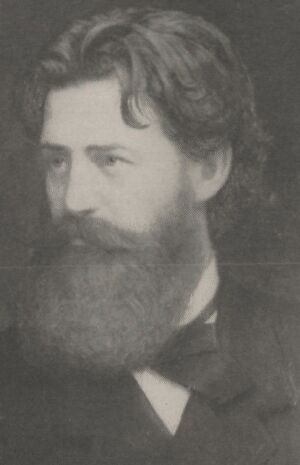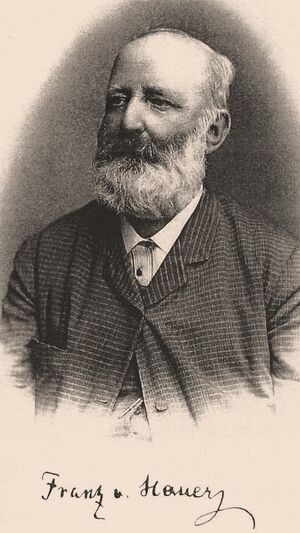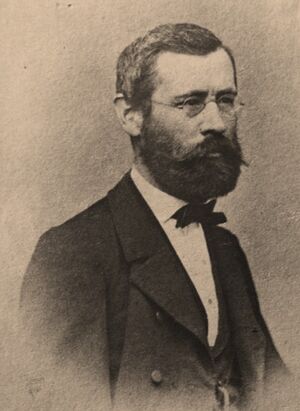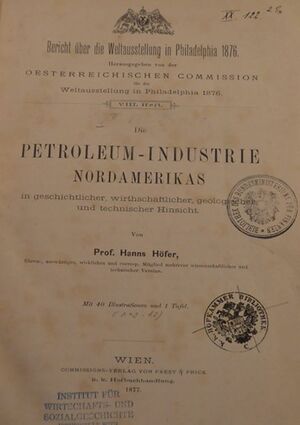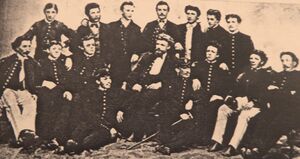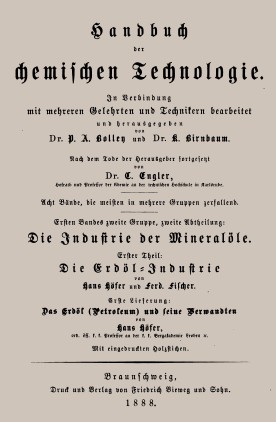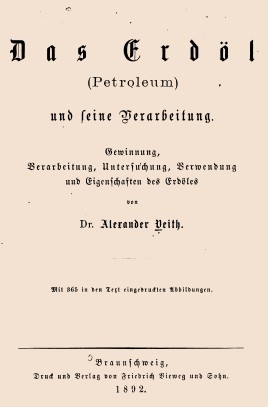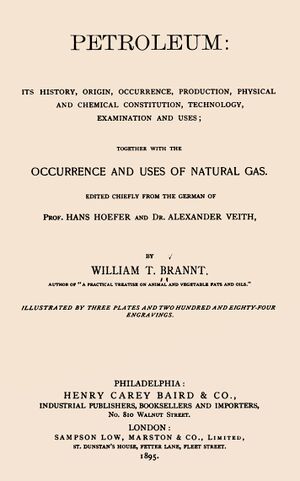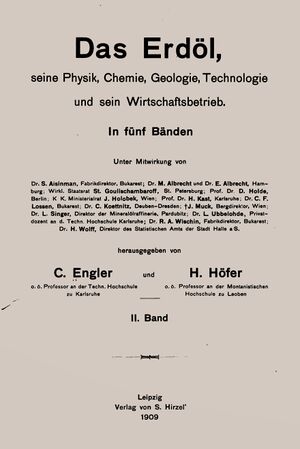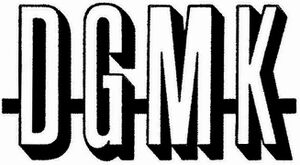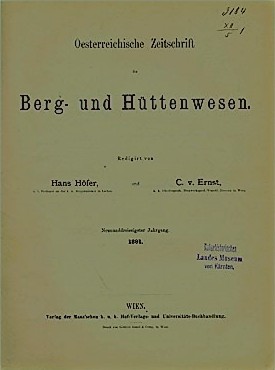Hans Höfer von Heimhalt
- Birthdate
- 1843
- Birthplace
- Elbogen, Bohemia, modern-day Loket, Czech Republic
- Death date
- 1924/02/09
- Fields of study
- Petroleum
Biography
The original version of this article was created by Francesco Gerali, 2020 Elizabeth & Emerson Pugh Scholar in Residence at the IEEE History Center
It is recommended this article be cited as:
F. Gerali (2020). Hans Höfer von Heimhalt, Engineering and Technology History Wiki. [Online] Available: https://ethw.org/Hans_H%C3%B6fer_von_Heimhalt
Early Career
The Austro-Hungarian mining engineer and Professor Hans Höfer von Heimhalt was born in 1843 in the town of Elbogen, Bohemia region - today Loket in the Czech Republic (Fig.1). Following a regular path of education in his town, he entered the prestigious Mining Academy of Leoben (Styria, Austria).[1] Graduating in 1864, he got his first job as Bergpraktikant (intern in mining) at the Transylvanian goldmines of Nagyág - today Săcărâmb, Romania, better known in the geology community as the place where the mineral Nagyágite was first discovered. In this capacity, Höfer depended on the central bureau of the Imperial Geological Survey of Vienna. He became a protégée of Franz Ritter von Hauer,[2] then director of the Survey and leading scholar, also a loyal monarchist and well respected in the Austro-Hungarian public administration (Fig.2). Hauer fostered the young Bohemian practitioner to improve his skills in research and writing, supported his career development, and introduced him to the contemporary leading entourage of geology and mining in the Austro-Hungarian Empire. This important mentoring summed up to his propension to learn, scientific curiosity, skills and shrewdness in cultivating public relations gave Höfer the opportunity to boost his professional path.
In 1865, Höfer moved to Přibram (modern-day Czech Republic) where he worked on new mining techniques in the state mines, producing lead and silver. In 1866, Höfer advanced to the rank of Bergwesen Expectant (deputy in mining). Shortly after, his wish to become part of the k.k. Geologische Reichsanstalt (Imperial Geological Survey) in Vienna was granted and he took a new position in the High Tatra Mountains (modern-day Vysoké Mountains, in Slovakia) and in the region of the Hungarian–Galician border (modern-day Ukraine). Within the Imperial Geological Survey, in cooperation with the chief geologist of the Survey in Vienna, Franz Foetterle (1823-1876), Höfer contributed to the completion of the first map displaying the production of coal for the entire Austrian–Hungarian Empire (Fig.3).
Höfer in 1869 was appointed Director of the recently instituted Mining School of Klagenfurt, in Carinthia. He received relevant support and cooperation from the Hüttenberger Eisenwerks-Gesellschaft (Hüttenberger Ironworks Society), the Bleiberger Bergwerks Gewerkschaft (Bleiberger Miners Union). Höfer together with many mining experts from Carinthia and Styria founded the Berg und Hüttenmänischer Verein für Kärnten (Mining Society of Carinthia) and a technical journal. Mining industrialists committed to finance the Mining School and the journal publication.
He participated in 1871 to the Ijsbjörn expedition to Spitzbergen, in the Svalbard Norwegian archipelago, but was not involved in the 1972-1874s Österreichisch-Ungarische Nordpolexpedition (Austrian-Hungarian North Pole Expedition of 1872-1874), also called Polarexpedition Admiral Tegetthoff, or just the Payer-Weyprecht. Sometimes Hofer is associated with the latter, but no historical sources support that. It is possible that Höfer, on the wave of the clamor generated by the landmarking Payer-Weyprecht expedition, empathized much on his 1871 Norwegian experience in the far north and facts overlapped in some chronicles.
Höefer and Petroleum
In 1875, Höfer was an affirmed member of the Austro-Hungarian cultural establishment, a renowned loyal nationalist, as well a respected expert in mining resources. He was commissioned by the Agriculture and Trade Secretary to travel to the 1876 World Exhibition in Philadelphia[3] to study and write a report about the North American petroleum sector. The United States was leading the global petroleum production and trade, and it was interfering with the Austro-Hungarian petroleum business modernization - still run through obsolete technologies and practices - and its goal was to gain more positions in the European energy market.
Höfer accomplished this task with a positive result. He made important scientific relations with fellow geologists and mining engineers in America (the American Institute of Mining Engineers conferred upon him foreigner correspondent membership) and in 1877 published, co-authored by his colleague Dr. Max Rothauer, the technical report Die Petroleum-Industrie Nordamerikas (Fig.4). This volume included a review on petroleum knowledge and technology in the USA and statistics about prices and production rates. In the petroleum historical literature, the work of Höfer can be included in the category of mining reports analyzing the USA petroleum business, written in the native language of the foreigner reporter, and very often were finalized to inform and help the government institutions and the entrepreneurship to set more competitive strategies.
Much of the information and the maps reported by Höefer were largely taken from the American-English literature; the geological core-subjects were chiefly based on the publication of Henry E. Wrigley, Frank Carll and other members of the Pennsylvania Geological Survey. Höfer wanted to enrich the work presenting his thesis about the origin and formation of petroleum, focusing much on the anticlinal theory. Because of that, Höefer sometimes is erroneously presented by recent historiography as the European developer of the anticlinal theory, but this idea is misleading. The latter, developed mostly from Canadian and U.S. scholars, was known in the international geological community since the early 1850s, but it was seldom considered such by European geologists as in Europe petroleum was found mostly in different geological structures.
Hoefer in 1879 was appointed Bergbau und Markscheidekunde (Professor of Mining) at the Mining Academy of Přibram (Fig.5). In 1881 he was appointed to teach geology and mineralogy at the Leoben Academy (now Leoben University). During this time in Leoben, Höfer focused a large part of his studies on petroleum geology and other technical aspects of the industry. Eventually, his research efforts converged in the publication of Das Erdöl und seine Verwandten. Geschichte, physikalische und chemische Beschaffenheit, Vorkommen, Ursprung, Auffindung und Gewinnung des Erdöls in 1888 (Fig.6). The book was the first comprehensive volume on petroleum science and technology written in the German language, and the first from Austria-Hungary. In 1892, Alexander Veith published a similar book on petroleum, Das Erdöl (Petroleum) und seine Verarbeitung. Gewinnung, Verarbeitung, Untersuchung, Verwendung und Eigenschaften des Erdöles, with the same publishing house, confirming the advancement of national scholarship on petroleum science (Fig.7). The success and the notoriety of Austro-Hungarian scholarship on petroleum peaked then in 1894 when the American chemical engineer William Theodore Brannt[4] translated in English part of the work of Höefer and Veith publishing it in the book Petroleum: its history, origin, occurrence, production, physical and chemical constitution, technology, examination and uses, together with the occurrence and uses of natural gas. (Fig.8).
Between 1909-1925, Höefer authored and edited the monumental Das Erdöl with his German colleague Carl Oswald Viktor Engler[5] (Fig.9). (Fig. 10). This was a forerunner encyclopaedia on petroleum upstream, midstream and downstream developed in six volumes, collecting the scholarship of numerous Austrian and German scientists. The scientific partnership between Höefer and Engler was not accidental, the latter was the German petroleum expert[6] most acknowledged at an international level (the DGMK - Deutsche Wissenschaftliche Gesellschaft für Erdöl, Erdgas und Kohle[7] awards since 1935 the Carl-Engler-Medaille, Fig. 11). This work was evidence of how much the German-Austrian knowledge on petroleum science was competitive when compared to the Anglo-Saxon and French schools, furthermore, it had a larger following in central-east Europe, Russia and the Caucasus.
Late career and life achievements
Höefer was a prolific author. He published 15 monographs, including textbooks, more than 150 journal articles, and worked also as co-editor for the Oesterreichische Zeitschrift für Berg und Hüttenwesen (Austrian Magazine for Mining and Metallurgy), one of the most influential journals in the field published in the Austro-Hungarian Empire (Fig. 12).
He retired from academic teaching in 1910. The Austrian government appointed Höefer Hofrat (counselor of the imperial court) and bestowed upon him the noble title of Edler von Heimhalt; eventually, the Mining Academy of Přibram made him Doctor Rerum Montanarum Honoris Causa. In 1923, Hofer was invited to the meeting of the American Association of Petroleum Geologists in Los Angeles to receive the Honorary Membership, but he had to decline because of the precarious health conditions. He died at age 81 in Vienna on February 9, 1924.
Since 1973, the Austrian Österreichische Gesellschaft für Erdölwissenschaften,[8] ÖGEW (Association for Petroleum Science, established in 1960) acknowledged Höfer’s scientific achievements instituting the Hans-Höfer-Medaille[9] (Fig.13).
Selected works of Hans Höfer von Heimhalt
Höfer von Heimhalt, Hans. 1865. “Tertiärconglomerat im Trachyt von Nagyág”. Zeitschrift der Deutschen Geologischen Gesellschaft 17: 333-337.
Höfer von Heimhalt, Hans. 1866. “Beiträge zur Kenntnis der Trachyte und Erzniederlage zu Nagyág in Siebenbürgen. Jahrbuch der kais”. Königl. Geologischen Reichs-Anstalt 16: 1-24
Höfer von Heimhalt, Hans. 1870. Die Mineralien Kärntens. Jahrbuch des Naturhistorischen Landesmuseums Kärnten. Klagenfurt: Ferdinand von Kleinmayr.
Höfer von Heimhalt, Hans. 1874a. “Über den Bau von Nowaja Semljas”. Petermanns Geographische Mittheilungen 20: 297-381
Höfer von Heimhalt, Hans. 1874b. “Beiträge zur Geographie Spitzbergens”. Petermanns Geographische Mittheilungen 20: 219-228
Höfer von Heimhalt, Hans. 1877. Die Petroleum-Industrie Nordamerikas in geschichtlicher, wirthschaftlicher, geologischer und technischer Hinsicht. Bericht über die Weltausstellung in Philadelphia 1876. Wien: Commissions–Verlag von Faesy & Frick k. k. Hofbuchhandlung.
Höfer von Heimhalt, Hans. 1879. “Gletscher und Eiszeit-Studien”. Sitzungsberichte der k. k. Akademie der Wissenschaften 79: 331-367
Höfer von Heimhalt, Hans. 1888. Das Erdöl und seine Verwandten. Geschichte, physikalische und chemische Beschaffenheit, Vorkommen, Ursprung, Auffindung und Gewinnung des Erdöls. Braunschweig: Friedrich Vieweg und Sohn. Second edition 1906; third edition 1912; fourth edition 1922.
Veith, Alexander. 1892. Das Erdöl (Petroleum) und seine Verarbeitung. Gewinnung, Verarbeitung, Untersuchung, Verwendung und Eigenschaften des Erdöles. Braunschweig, F. Vieweg und Sohn.
Höfer von Heimhalt, Hans. 1906. Das Erdöl und seine Verwandten. Geschichte, physikalische und chemische Beschaffenheit, Vorkommen, Ursprung, Auffindung du Gewinnung des Erdöles. Handbuch der chemischen Technologie. Second Edition. Braunschweig: Friedrich Vieweg und Sohn.
Engler, K. Oswald Viktor., Höfer von Heimhalt, H. (Eds.). 1909-1925. Das Erdöl, seine Physik, Chemie, Geologie, Technologie und sein Wirtschaftsbetrieb. Leipzig: S. Hirzel. In Six Volumes:
- Band Die Chimie und Physik des Erdöls.
- Band Die Geologie, Gewinnung und der Transport des Erdöls.
- Band Die Technologie des Erdöls und seiner Produkte.
- Band Die Prüfung und Verwendung des Erdöls, des Erdgases und der Erdölprodukte.
- Band Die Erdölwirtschaft (I)).
- Band Die Erdölwirtschaft (II).
Höfer von Heimhalt, Hans. 1909. “Die Entstehung der Erdöllagerstätten. Vortrag gehalten in der geologischen Gesellschaft in Wien”. Österreichische Zeitschrift für Berg und Hüttenkunde, LVII: 331-335.
Höfer von Heimhalt, Hans. 1914 “Geologie”. In: Die Geologie, Gewinnung und Transport des Erdöls, Engler, C. and Höfer, H. (eds)
Höfer von Heimhalt, Hans. 1915. Anleitung zum geologischen Beobachten, Kartieren und Profilieren. Leipzig: S. Hirzel.
See also
- Thomas Boverton Redwood
- Ludger Benedikt Mintrop
- John Franklin Carll
- Arthur Wade
- American Institute of Mining, Metallurgical and Petroleum Engineers
References
Brannt, William T. 1894. Petroleum: its history, origin, occurrence, production, physical and chemical constitution, technology, examination and uses-- together with the occurrence and uses of natural gas. Edited chiefly from the German of Hans Hoefer and Alexander Veith by William T. Brannt. Philadelphia, Pa.: H. C. Baird ; c1894.
Ettre, L. S. 1995. “Early petroleum chemists and the beginnings of chromatography”. Chromatographia 40, 207–216 (1995).
Frank, Allison. Oil empire: visions of property in Austrian Galicia. Massachusetts, London: Harvard University Press, 2005.
Gattnar, F. 1924. “Nekrologe. Hans Höfer-Heimhalt”. Mitteilungen der geologischen Gesellschaft in Wien 17:79-92.
Schatzker, Valerie, Hirszhaut, Julien. 2015. The Jewish oil magnates of Galicia: The Jewish Oil Magnates: A history, 1853 1945. Montreal & Kingston: McGill-Queen's University Press.
Höfer von Heimhalt, Hans. 1888. Das Erdöl und seine Verwandten. Geschichte, physikalische und chemische Beschaffenheit, Vorkommen, Ursprung, Auffindung und Gewinnung des Erdöls. Braunschweig: Friedrich Vieweg und Sohn.
Owen, Edgar Wesley. 1975. Trek of the oil finders: a history of exploration for petroleum. Tulsa: American Association of Petroleum Geologists.
Strippelmann, Leo. 1878. Die Petroleum-Industrie Oesterreich-Deutschlands: dargestellt zur Klarstellung deren Wichtigkeit und Zukunft, und zur Aufklärung des, für diese Industrie sich interessirenden Capital’s in geschichtlicher, geologisch-bergmännischer, wirthschaftlicher und technischer Beziehung. Leipzig: G. Knapp, Verlagsbuchhandlung.
Szczepanowski St. 1898. “Die Entwicklung der Petroleumindustrie in Galizien”. In: Die Großindustrie Oesterreichs. Wien: Leopold Weiss.
Payer, Julius. 1875. “The Austro-Hungarian Polar Expedition of 1872-4”. The Journal of the Royal Geographical Society of London 45: 1-19.
Vaccari, Ezio. 1999. “Austro-Italian Scientific Relationships in the field of the Earth Sciences. The Geologische Reichsanstalt and the geologists of the Lombardo-Venetian Kingdom (1850-1866)”. Geologie ohne Grenzen Festschrift 150 Jahre Geologische Bundesanstalt - Abhandlungen Der Geologischen Bundesanstalt 56, no. 1: 95-114.
Veith, Alexander. 1892. Das Erdöl (Petroleum) und seine Verarbeitung. Gewinnung, Verarbeitung, Untersuchung, Verwendung und Eigenschaften des Erdöles. Braunschweig, F. Vieweg und Sohn.
Wrigley HE, Jones LD, Lesley JP. 1875. Special report on the petroleum of Pennsylvania: its production, transportation, manufacture and statistics. Geological Survey of Pennsylvania, report of progress. Harrisburg: Board of Commissioners to the Second Geological Survey.
Wróblewski, Adam. 1924. “Obituary. Hans von Höfer”. Bulletin of the American Association of Petroleum Geologists no. 8: 534
Further Reading
- ↑ https://www.unileoben.ac.at/en/university/history
- ↑ https://www.unileoben.ac.at/en/university/history
- ↑ https://www.lcpimages.org/centennial/
- ↑ https://id.loc.gov/authorities/names/n91032312.html
- ↑ https://www.catalogus-professorum-halensis.de/englercarl.html
- ↑ https://portal.dnb.de/opac.htm?method=simpleSearch&query=116504412
- ↑ https://dgmk.de/ueber-dgmk/geschichte-der-dgmk/
- ↑ http://worldcat.org/identities/lccn-n86043316/
- ↑ https://www.wko.at/site/OEGEW/Die-Gesellschaft/hans-hoefer-medaille.html
